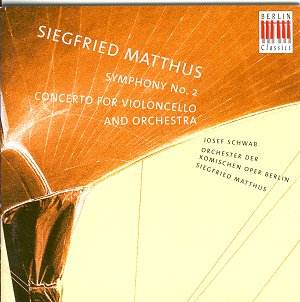Siegfried Matthus’s Cello Concerto, completed
in 1975, is a quite substantial work in three movements played without
a break, cast in an accessible, expressionist idiom somewhat redolent
of, say, Berg or late Lutoslawski. The first movement opens with an
arresting brass gesture and then alternates episodes of calm or violence,
all based on germ cells stated at the very beginning of the piece. The
cello, in turn declamatory or lyrical, is present most of the time.
The mood of the first movement is troubled, anguished and at times angry,
but there are some moments of respite such as the beautiful cantabile
section about half way through the movement, magically scored for cello
and strings. The first movement ends with a big cadenza leading straight
into the second movement Lento; for the most part a peaceful,
delicately scored rêverie, the course of which is at times
disrupted by more disturbing episodes. The final Prestissimo,
a brilliant nervous rondo, does much to dispel the tension accumulated
in the course of the preceding movements though its final peroration
is hard won indeed, if at all, for the movement ends with a mighty orchestral
glissando, a dismissive Basta! rather than a triumphant
Yawp! Matthus’s Cello Concerto is an impressive piece of music
that definitely deserves to be better known and picked-up by cellists
willing to add a warmly expressive, deeply human new work to their repertoire.
The Second Symphony of 1976 has much
in common with the Cello Concerto as to its aims and means. It is laid-out
in the customary four movements though these again are played without
breaks - emphasising the thematic unity of the work which develops earlier
material throughout its length. The opening Sostenuto begins
rather cautiously, in a brooding mysterious mood, but the brass soon
state a more assertive motive. The movement alternates these basic materials
without any real development and without reaching any real climax, uncertainty
and ambiguity prevailing throughout the movement which ends with a varied
restatement of its opening. Nervous fanfares lead into the uneasy, agitated
Scherzo section Allegro assai which at the ends peters
out and leads into the Lento section which has much in common
with the slow movement of the Cello Concerto, especially its delicate
scoring with lightly tinkling sounds, long melodic lines as the one
played by the flute right at the start. However the predominantly nocturnal
mood of the slow movement is disturbed by a more agitated central section.
A restatement of the opening melody, now played by the oboe, ends the
movement but is interrupted by the bassoon introducing the Finale Allegro
moderato, also some sort of nervous rondo moving along at great
speed towards the surprisingly subdued and questioning conclusion. Again,
a very fine piece of music of great expressive power.
These fine works undoubtedly deserve to be better known
and these 1978 recorded performances conducted by the composer serve
them well (and still sound remarkably well). 20th Century
mainstream symphonism, maybe, but well worth investigating for Matthus’
music is deeply honest, uncompromising though highly communicative.
Hubert CULOT


